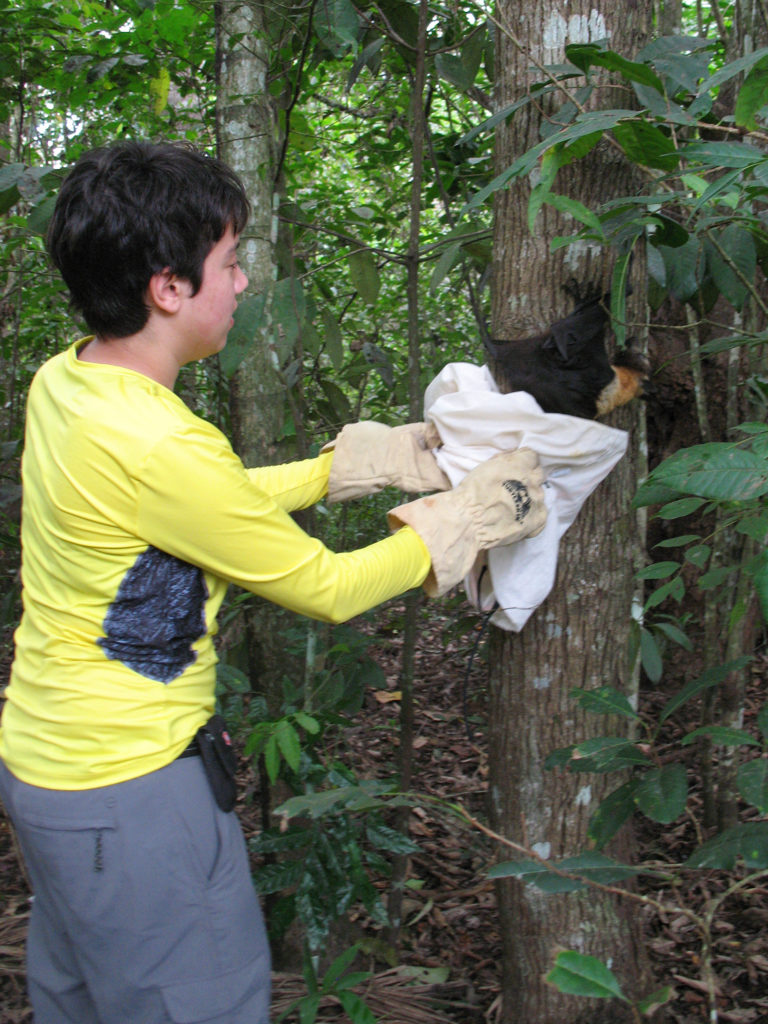Athens, Ga. – Volunteer wildlife rehabilitators in Australia help protect the public from diseases carried by bats. A new study provides recommendations for future investment by state and territory governments that could reduce health risks to the volunteers themselves.
Conducted by the University of Georgia and the Commonwealth Scientific and Industrial Research Organisation Australian Animal Health Laboratory, the study was just published in PLOS Neglected Tropical Diseases.
Fruit bats in Australia, known as flying foxes, play important ecological roles as pollinators and dispersers of seeds, but they may also harbor diseases that can be fatal to livestock and people. These include Hendra virus, which can be transmitted from flying foxes to horses and from horses to humans, and Australian bat lyssavirus, which is similar to rabies and can be transmitted from bats directly to humans via scratches or bites.
When wild bats are injured, whether due to extreme heat waves or run-ins with barbed wire, power lines or netting on fruit trees, a network of dedicated volunteers steps in. These volunteers, known as carers, rescue and rehabilitate injured, ill and orphaned flying foxes. Their efforts help bats and protect public safety by ensuring that members of the general public aren’t exposed to the diseases the bats may be carrying.
Cecilia A. Sánchez, a doctoral student in the UGA Odum School of Ecology who studies emerging infectious diseases in flying foxes, became interested in the risks from infected bats to carers after interacting with several carers in Australia.
Sánchez said that carers, like researchers, take precautions. They are vaccinated against rabies, which protects them from lyssavirus. And most use personal protective equipment-PPE for short-when handling bats.
“As a researcher in the field, I wore two layers of nitrile gloves, gauntlets, a hat and long-sleeved shirts and long pants,” she said. “But with carers, everyone has their own standards.”
Some carers are part of groups that require certain safety measures, but others work independently. And while carer organizations require all their volunteers to be vaccinated, there is no national standard for PPE.
“Carers provide an important community service, but it can put them at risk,” Sánchez said. “There was not much research on what the carers think of that risk or how they’re protecting themselves.”
To find out, Sánchez and Michelle L. Baker of the CSIRO Australian Animal Health Laboratory conducted a survey of carers across Australia. They received 122 complete responses.
All survey participants reported being vaccinated against rabies, and the vast majority—94 percent—said they were tested for rabies antibodies at least every two years.
There was a wide variation in the use of PPE, however.
Ten percent of carers said they wore nitrile rubber gloves, and 16 percent said they wore heavy gloves when handling flying foxes. Half of the carers said they used other forms of PPE including towels or blankets, arm protectors or goggles. Just over one-quarter said they used no PPE at all.
Sánchez and Baker also asked whether carers had been injured by the bats they were helping. Eighty-three percent said they had been bitten or scratched—and therefore potentially exposed to disease—while working with bats. Those who wore no PPE were the most likely to have been bitten or scratched, while carers who wore heavy gloves were the least likely.
Post-exposure care also varied, ranging from carers who reported that they would take no action after a scratch or bite to others who said they would wash the wound, apply an antiseptic and receive a rabies booster shot.
Sánchez said their results show carers are taking important steps to reduce their own risk, but there is room for improvement. That is why she and Baker recommend the development of Australia-wide safety guidelines for carers, as well as financial support for the purchase of PPE.
“Carers are already doing a lot of great things like getting vaccinated, and most are using some form of PPE,” Sánchez said. “And while some PPE is better than nothing, the heavier-duty PPE is the most protective-but cost can be a barrier.
“Governments are relying on these volunteers to provide an important public service. That’s why we are suggesting government agencies step up and help.”
The study, “Disease Risk Perception and Safety Practices: A Survey of Australian Flying Fox Rehabilitators,” is available online at http://journals.plos.org/plosntds/article?id=10.1371/journal.pntd.0004411.
For more information about the Odum School of Ecology, visit www.ecology.uga.edu. For more about the CSIRO Australian Animal Health Laboratory, visit www.csiro.au/en/Research/Facilities/AAHL.
